September 24th Scots Book of Days
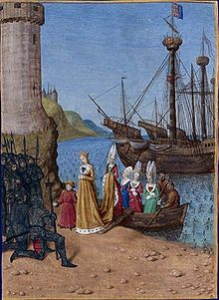 September 24 – 1326 Invasion of England (1326) Isabella of France [She-wolf of France], was Queen consort of England as the wife of Edward II King of England. Isabella and Roger Mortimer of Wigmore landed at Orwell on the east coast of England on 24 September with a small army estimated from between 300 to around 2,000 soldiers, with 1,500 being a popular middle figure. Ancestors of Scottish royalty from 15th century on.
September 24 – 1326 Invasion of England (1326) Isabella of France [She-wolf of France], was Queen consort of England as the wife of Edward II King of England. Isabella and Roger Mortimer of Wigmore landed at Orwell on the east coast of England on 24 September with a small army estimated from between 300 to around 2,000 soldiers, with 1,500 being a popular middle figure. Ancestors of Scottish royalty from 15th century on.
Isabella landing in England with her son, the future Edward III in 1326. Isabella `the She-Wolf’ of FRANCE Queen of ENGLAND, and ruled with Mortimer; spent last 29 years of her life in captivity Born: 1292 Died: 1358. HM George I’s 10-Great Grandmother. PM Churchill’s 17-Great Grandmother. James I STEWART (37th King) of SCOTS 2ND Great Grandmother-in-law http://fabpedigree.com/s053/f041446.htm
Roger (de) MORTIMER 1st Earl of MARCH; de facto co-ruler of England with Queen Born: Hereford 1287 Died: 1330. PM Churchill’s 17-Great Grandfather. Lady Diana’s 17-Great Grandfather. PM Cameron’s 17-Great Grandfather. HM George I’s 13-Great Grandfather.
http://fabpedigree.com/s038/f187547.htm
 1332 Scone, a village in Gowrie, Perth Scotland. John Baliol crowned King of Scotland. Tytler’s Britannica. ‘he shewed how unworthy he was to wear it.’
1332 Scone, a village in Gowrie, Perth Scotland. John Baliol crowned King of Scotland. Tytler’s Britannica. ‘he shewed how unworthy he was to wear it.’
Map of the area of Perth. Gowrie and Scone are about at the top of the P in Perth.
1554 – Knox received an invitation from a congregation of English exiles in Frankfurt to become one of their ministers.
1584 Privy Council ordered to stop all traffic, from Fife, Perth, north of the Forth, take sails off ferry boats exceptions. September 24. A History of Epidemics in Britain from A.D. 664 to the Extinction of Plague Charles Creighton, M.A. M.D. Demonstrator of Anatomy University of Cambridge. 1891
1584 September 24 – 1584 to august 1585 Perth, 1437 died. A History of Epidemics in Britain from A.D. 664 to the Extinction of Plague Charles Creighton, M.A. M.D. Demonstrator of Anatomy University of Cambridge. 1891
1606 William Douglas, Laird of Lochleven; One of 24 Lords of the Congregation. 6th Earl of Morton, William Douglas, 6th Earl of Morton1
M, b. 1539/40, d. circa 24 September 1606
Douglas 1036 2Stewart 2Ruthven 2Kinchin 2Jared 2Simmons 2Choate – Douglas 2Montgomberie 2Blair 2Cochrane 2Miller 2Simmons 2Choate – Douglas 2Hamilton 2Stewart 2Miller 2Simmons 2Choate – Douglas 2Carlyle 2Semple 2Montgomery 2Cochrane 2Miller 2Simmons 2Choate
William Douglas, 6th Earl of Morton was born in 1539/40.2 He was the son of Sir Robert Douglas of Lochleven. He married Lady Agnes Leslie, daughter of George Leslie, 4th Earl of Rothes and Margaret Crichton, on 19 August 1554.
Crichton of Brunstone 1100 2Gordon2Kennedy 2Stewart2Miller 2Simmons2Choate
Morton died circa 24 September 1606. Douglas gained the title of 6th Earl of Morton.3
Child of William Douglas, 6th Earl of Morton Lady Christian Douglas4
Children of William Douglas, 6th Earl of Morton and Lady Agnes Leslie
James Douglas5, , Margaret Douglas, Eupheme Douglas
Robert Douglas, Master of Morton d. Mar 1584/85
Elizabeth Douglas, Mary Douglas, Sir Archibald Douglas of Keillor d. 1649
Lady Agnes Douglas1 b. 1574, d. 3 May 1607
Citations
G.E. Cokayne; with Vicary Gibbs, H.A. Doubleday, Geoffrey H. White, Duncan Warrand and Lord Howard de Walden, editors, The Complete Peerage of England, Scotland, Ireland, Great Britain and the United Kingdom, Extant, Extinct or Dormant, new ed., 13 volumes in 14 (1910-1959; reprint in 6 volumes, Gloucester, U.K.: Alan Sutton Publishing, 2000), volume I, page 202. Hereinafter cited as The Complete Peerage. volume IX, page 293, page 625. volume IV, page 436
Charles Mosley, editor, Burke’s Peerage, Baronetage & Knightage, 107th edition, 3 volumes (Wilmington, Delaware, U.S.A.: Burke’s Peerage (Genealogical Books) Ltd, 2003), volume 2, page 1949. Hereinafter cited as Burke’s Peerage and Baronetage, 107th edition. volume 1, page 113. volume 2, page 2787.
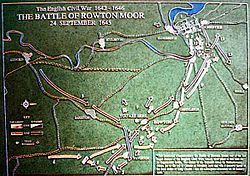 1645 , Battle of Rowton Heath Surrender of Leicester
1645 , Battle of Rowton Heath Surrender of Leicester
Battle of Rowton Moor Plan. the English Civil War between the Parliamentarians, commanded by Sydnam Poyntz, and the Royalists under the personal command of King Charles I. Rowton Heath has been called “a major disaster” for King Charles, with casualties estimated at 600 dead and 900 injured, including 50 members of the Life Guard and Lord Stewart. Parliamentarian losses were also heavy, although unknown, and the battle did give Chester some respite. Despite this, Charles withdrew the next day with the remaining 2,400 horse, heading to Newark-on-Trent. The remaining Royalist cavalry were eventually destroyed in their entirety when Poyntz ambushed them at Sherburn-in-Elmet on 15 October 1645. Chester was left without additional support, and surrendered to the Parliamentarians on 3 February 1646.
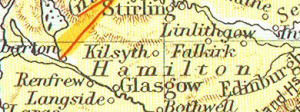 1715 Duke of Argyle saw the danger of being thus cut off from the western counties, where Government had many zealous adherents; for he ordered up five hundred men from Glasgow to join his camp at Stirling [TG68-304].
1715 Duke of Argyle saw the danger of being thus cut off from the western counties, where Government had many zealous adherents; for he ordered up five hundred men from Glasgow to join his camp at Stirling [TG68-304].
A century and a half later, Utah’s important sugar industry received major impetus through the efforts of David Eccles, once a peddler of rolling pins in the streets of Glasgow and later a noted Utah businessman.
Stirling on the River Forth, is about 2 dozen miles north and east of Glasgow on the River Clyde.
1745 Sept. 24. ITINERARY Alexander MacLeod, of Muiravonside, advocate, sent to Skye to summon Sir Alex. MacDonald, MacLeod of MacLeod, and MacKinnon of MacKinnon, his credential l stating that the Prince had positive assurance of assistance from France and Spain.2 Kinloch-Moidart, Fraser of Dulcraig, and MacDonald of Barrisdale were sent with a similar message to Lord Lovat (J.M.B., etc.). Muiravonside Country Park is 170 acres of woodland and parkland open to the public all year round with marked trails, picnic sites and a play area. It is situated in the south-east corner of the area of Falkirk, two miles south of Grangemouth. It was once the grounds of Muiravonside House and the country estate owned by the Stirling family of Falkirk. In 1724, the estate was sold to John MacLeod, an Edinburgh advocate. This family had a long history of supporting the return of the Stuarts to the throne, Alexander McLeod, who stayed at Muiravonside, was one of Bonnie Prince Charlie’s aide de camp. Leading up to the Jacobite rising of 1745 these Jacobite sympathisers were amongst those plotting the return the Stuarts.
http://www.electricscotland.com/webclans/m/macleod2.html Septs of Clan MacLeod of Harris: Beaton, Bethune, Beton, MacCaig, MacClure, MacCrimmon, MacCuaig, MacHarrold, Macraild, Norman. Septs of Clan MacLeod of Lewis: Callum, Lewis, MacAskill, MacAulay, MacCallum, MacCaskill, MacCorkindale, MacCorquodale, MacLewis, MacNicol, Malcolmson, Nicholl, Nicol, Nicoll, Nickolson, Nicolson, Tolmie.
Publications OF THE SCOTISH HISTORY SOCIETY VOLUME XXIII p. 33 (18)
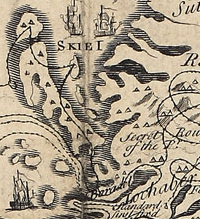 April 1897 SUPPLEMENT LYON IN MOURNING PRINCE CHARLES EDWARD STUART ITINERARY AND MAP. Ed.W. B. BLAIKIE, from Narrative of Lord MacLeod, son of the Earl of Cromarty, in the Peerage of Scotland in 1703 for Sir George Mackenzie, 2nd Baronet, George Mackenzie, 1st Earl of Cromartie (1630–1714), John Mackenzie, 2nd Earl of Cromartie (c.1656–1731) had son George Mackenzie, 3rd Earl of Cromartie (c.1703–1766) (forfeit in 1746) He married Isabel Gordon, daughter of Sir William Gordon of Invergordon, on 23 September 1724 . Skye Isle, Mull,
April 1897 SUPPLEMENT LYON IN MOURNING PRINCE CHARLES EDWARD STUART ITINERARY AND MAP. Ed.W. B. BLAIKIE, from Narrative of Lord MacLeod, son of the Earl of Cromarty, in the Peerage of Scotland in 1703 for Sir George Mackenzie, 2nd Baronet, George Mackenzie, 1st Earl of Cromartie (1630–1714), John Mackenzie, 2nd Earl of Cromartie (c.1656–1731) had son George Mackenzie, 3rd Earl of Cromartie (c.1703–1766) (forfeit in 1746) He married Isabel Gordon, daughter of Sir William Gordon of Invergordon, on 23 September 1724 . Skye Isle, Mull,
1773 Alexander Stewart, 6th Earl of Galloway (d 24.09.1773) died. Alexander was the son of James Stewart, 5th Earl of Galloway by Catherine, daughter of Alexander Montgomerie, 9th Earl of Eglinton (c.1660-1729). Grand Master of the Grand Masonic Lodge of Scotland
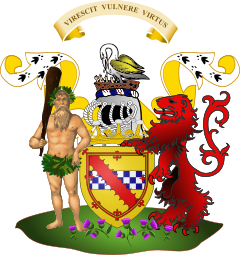 1757–1759. Married (05.01.1729) Catherine Cochrane (d 15.03.1786) 4th child of John Cochrane, 4th Earl of Dundonald (b 04.07.1687, d 05.06.1720).
1757–1759. Married (05.01.1729) Catherine Cochrane (d 15.03.1786) 4th child of John Cochrane, 4th Earl of Dundonald (b 04.07.1687, d 05.06.1720).
Coat of arms of The Earl of Galloway
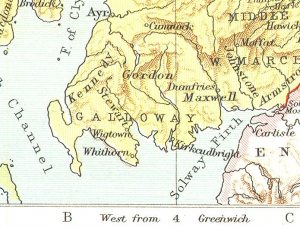 Galloway on the Solway Firth. Kirkcudbright is noticed in the next entry as the birthplace of John Paul Jones.
Galloway on the Solway Firth. Kirkcudbright is noticed in the next entry as the birthplace of John Paul Jones.
1779 Most of Bonhomme Richard’s crew immediately transferred to other vessels, and after a day and a half of frantic repair efforts, Jones decided that the ship could not be saved, so it was allowed to sink. The day after 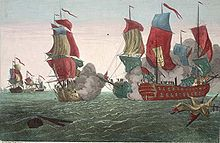 the Battle of Flamborough Head the 50-gun British frigate HMS Serapis awakens with a new Captain, John Paul Jones who was born on the estate of Arbigland near Kirkbean in the Stewartry of Kirkcudbright on the southwest coast of Scotland.
the Battle of Flamborough Head the 50-gun British frigate HMS Serapis awakens with a new Captain, John Paul Jones who was born on the estate of Arbigland near Kirkbean in the Stewartry of Kirkcudbright on the southwest coast of Scotland.
Engraving based on the painting Action Between the Serapis and Bonhomme Richard by Richard Paton, published 1780.
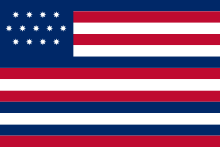 Captain Jones took command of the 42-gun Bonhomme Richard which with the Alliance, were matched against the 50-gun British frigate HMS Serapis and the 20-gun hired escort Countess of Scarborough. Quickly recognizing that Jones could not win a battle of big guns, and with the wind dying, Jones made every effort to lock Richard and Serapis together (his famous quotation, “I have not yet begun to fight!” was uttered in reply to a cheerful British taunt during an odd stalemate in this phase of the battle), finally succeeding after about an hour, following which his deck guns and his Marine marksmen in the rigging began clearing the British decks. Alliance sailed past and fired a broadside, doing at least as much damage to the Richard as to the Serapis. Jones took command of Serapis for the trip to neutral (but American-sympathizing) Holland.
Captain Jones took command of the 42-gun Bonhomme Richard which with the Alliance, were matched against the 50-gun British frigate HMS Serapis and the 20-gun hired escort Countess of Scarborough. Quickly recognizing that Jones could not win a battle of big guns, and with the wind dying, Jones made every effort to lock Richard and Serapis together (his famous quotation, “I have not yet begun to fight!” was uttered in reply to a cheerful British taunt during an odd stalemate in this phase of the battle), finally succeeding after about an hour, following which his deck guns and his Marine marksmen in the rigging began clearing the British decks. Alliance sailed past and fired a broadside, doing at least as much damage to the Richard as to the Serapis. Jones took command of Serapis for the trip to neutral (but American-sympathizing) Holland.
The “John Paul Jones flag” was entered into Dutch records to help Jones avoid charges of piracy when he captured the Serapis under an “unknown flag.”
1824 Admiral Sir Arthur Auckland Leopold Pedro Cochrane KCB (Commander of HMS Niger), b. 24 Sep 1824, d. 20 Aug 1905. m. Born the third son of the tenth Earl of Dundonald, Cochrane joined the Royal Navy in 1839. He fought at Acre where he was wounded during the Oriental Crisis in 1840 and then served in the Baltic Sea during the Crimean War where he devised a method of towing torpedoes to their target using kites in 1855. . Knight Commander of the Order of the Bath. Commander-in-Chief, Pacific Station in 1873
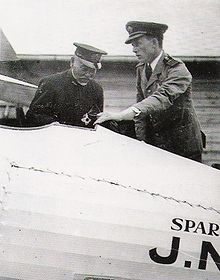 1893 William Francis Forbes-Sempill, 19th Lord Sempill (1893–1965) born.
1893 William Francis Forbes-Sempill, 19th Lord Sempill (1893–1965) born.
Captain Sempill showing a Gloster Sparrowhawk to Admiral Togo Heihachiro, 1921. Forbes-Sempill was involved in the aircraft industry from its early days, both as a flyer and as an engineer. During World War I, he enrolled in the Royal Flying Corps; by the end of the war he held the rank of colonel. He became a test pilot and transferred into the Royal Naval Air Service.
Sempill Crest: A stag’s head Argent attired with ten tynes Azure and collared with a prince’s crown Or. Motto: KEEP TRVST. Chief: James William Stuart Whitmore Sempill, 21st Lord Sempill
1900 Florida’s flag features the flag of Scotland with St Andrew’s saltire 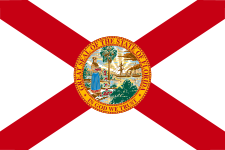 Red saltire on a white background, with the Seal of Florida superimposed on the center.
Red saltire on a white background, with the Seal of Florida superimposed on the center.
Disclaimer: The author of each article published on this web site owns his or her own words. The opinions, beliefs and viewpoints expressed by the various authors and forum participants on this site do not necessarily reflect the opinions, beliefs and viewpoints of Utah Standard News or official policies of the USN and may actually reflect positions that USN actively opposes. No claim in public domain or fair use. © John Choate.
Utah Standard News depends on the support of readers like you.
Good Journalism requires time, expertise, passion and money. We know you appreciate the coverage here. Please help us to continue as an alternative news website by becoming a subscriber or making a donation. To learn more about our subscription options or make a donation, click here.
To Advertise on UtahStandardNews.com, please contact us at: ed@utahstandardnews.com.


Comments - No Responses to “September 24th Scots Book of Days”
Sure is empty down here...